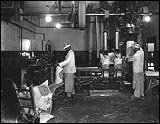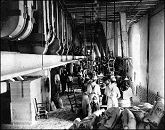In the days when flour mills were small local operations, farmers from the surrounding countryside sold their wagonloads of wheat directly to the miller - a procedure that was abandoned when large mills and a railroad network were developed. This led to a web of grain elevators throughout the state, and the creation of grain-trading organizations in strategic locations such as St. Paul, Minneapolis, Duluth, etc.
Continuing pressures to modernize milling and distribution facilities required huge investments to meet growing national and world competition. Centralization of these huge industries created the need for the farmers, grain handlers and milling workers to seek job security and equity through cooperative efforts. [MIACOC] |
|
|
Flour Millers

Sacking Department, R. Miller Milling Company, July 31, 1924
Photo by Hibbard, Ctsy Minnesota Historical Society

Sacking flour, Pillsbury A Mill, 1902
Minnesota Historical Society
|





